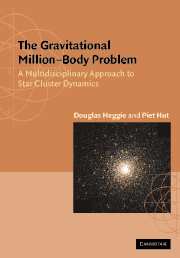Book contents
- Frontmatter
- Contents
- Preface
- PART I INTRODUCTIONS
- PART II THE CONTINUUM LIMIT: N → ∞
- PART III MEAN FIELD DYNAMICS: N = 106
- PART IV MICROPHYSICS: N = 2
- PART V GRAVOTHERMODYNAMICS: N = 106
- PART VI GRAVITATIONAL SCATTERING: N = 3
- PART VII PRIMORDIAL BINARIES: N = 4
- PART VIII POST-COLLAPSE EVOLUTION: N = 106
- 27 Surviving Core Collapse
- 28 Gravothermal Oscillations
- 29 Dissolution
- PART IX STAR CLUSTER ECOLOGY
- Appendix A A Simple N-Body Integrator
- Appendix B Hints to Solution of Problems
- References
- Index
29 - Dissolution
Published online by Cambridge University Press: 05 June 2012
- Frontmatter
- Contents
- Preface
- PART I INTRODUCTIONS
- PART II THE CONTINUUM LIMIT: N → ∞
- PART III MEAN FIELD DYNAMICS: N = 106
- PART IV MICROPHYSICS: N = 2
- PART V GRAVOTHERMODYNAMICS: N = 106
- PART VI GRAVITATIONAL SCATTERING: N = 3
- PART VII PRIMORDIAL BINARIES: N = 4
- PART VIII POST-COLLAPSE EVOLUTION: N = 106
- 27 Surviving Core Collapse
- 28 Gravothermal Oscillations
- 29 Dissolution
- PART IX STAR CLUSTER ECOLOGY
- Appendix A A Simple N-Body Integrator
- Appendix B Hints to Solution of Problems
- References
- Index
Summary
The previous chapter dealt mostly with a highly idealised model. All stars were single and had the same mass, and the system was isolated. As we saw, even the presence of a spectrum of stellar masses changes the picture, as it is found that gravothermal oscillations set in only for considerably larger values of N. In the present chapter we shall also see that the presence of primordial binaries further weakens their probable relevance. Even when gravothermal oscillations do occur, they seriously affect the structure of only the innermost 1% or so of a cluster. Therefore, in this chapter we concentrate once more on the steady post-collapse evolution of a stellar system. Also, we mainly have in mind a system with a significant population of primordial binaries, and boundary conditions set by the tidal field of the surrounding galaxy. First, however, we consider the simpler case of an isolated cluster.
Isolated clusters
The first thing that is changed in post-collapse evolution when we add primordial binaries is the radius of the core. A similar argument to that of Box 28.1 shows that the ratio rh/rc is now almost independent of N (cf. Problem 1). In fact the ratio depends more on the proportion of binaries (which decreases as the binaries are consumed).
These statements greatly weaken the clues to the occurrence of gravothermal oscillations which we discussed in the case of post-collapse evolution powered by three-body binaries (Chapter 28).
- Type
- Chapter
- Information
- The Gravitational Million–Body ProblemA Multidisciplinary Approach to Star Cluster Dynamics, pp. 272 - 276Publisher: Cambridge University PressPrint publication year: 2003



